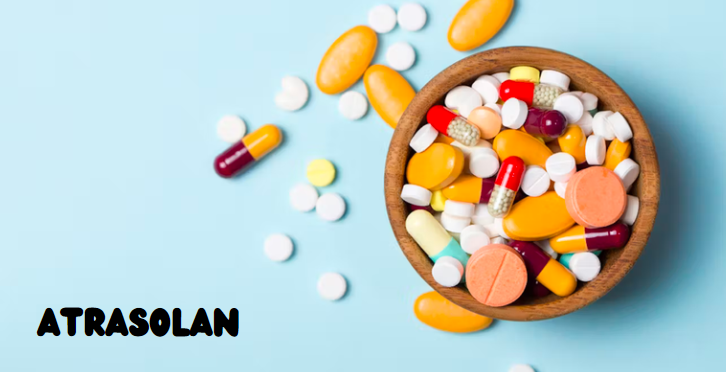A Comprehensive Guide to Atrasolan: Uses, Benefits, Side Effects, and More
Introduction
In today’s fast-paced world, anxiety has become a common issue for many people. For those grappling with anxiety, including anxiety caused by depression, medications like atrasolan offer relief. However, understanding the intricacies of any medication is crucial for effective treatment.
This comprehensive guide delves deep into atrasolan, exploring its uses, benefits, side effects, and much more. Whether you’re a healthcare professional or someone considering this medication, this article aims to provide you with valuable insights that go beyond what is typically found online.
What is Atrasolan?
Atrasolan is a prescription medication primarily used to alleviate symptoms of anxiety. It belongs to the benzodiazepine class, a group of medications known for their sedative and calming effects. While atrasolan is particularly effective for treating anxiety disorders, it is also prescribed for anxiety that stems from depression. Its mechanism of action involves enhancing the activity of gamma-aminobutyric acid (GABA), a neurotransmitter in the brain that induces relaxation and reduces nervous tension.
The Chemistry Behind Atrasolan
At a molecular level, atrasolan functions by binding to the GABA receptors in the brain. This binding action increases GABA’s inhibitory effects, leading to a calming effect on the nervous system. Unlike some other benzodiazepines, atrasolan has a relatively short half-life, meaning it works quickly and is metabolized efficiently by the body. This feature makes it particularly useful for managing acute anxiety episodes.
The Uses of Atrasolan
Treating Generalized Anxiety Disorder (GAD)
Generalized Anxiety Disorder (GAD) is a condition characterized by excessive and uncontrollable worry about various aspects of life. Atrasolan is commonly prescribed to manage the symptoms of GAD, including restlessness, irritability, muscle tension, and difficulty concentrating. Patients typically report a significant reduction in anxiety symptoms within a short period after starting atrasolan.
Anxiety Linked to Depression
Depression and anxiety often coexist, creating a complex set of symptoms that can be difficult to manage. Atrasolan is particularly effective in cases where anxiety is a direct result of depressive episodes. The medication helps by not only reducing anxiety but also by improving sleep and reducing agitation, which are common symptoms in depressive disorders.
Short-Term Management of Panic Attacks
Panic attacks are sudden and intense episodes of fear that can be debilitating. Atrasolan is sometimes used as a short-term treatment option for panic attacks due to its fast-acting properties. By quickly calming the nervous system, atrasolan can help prevent the escalation of a panic attack, making it a valuable tool for those who experience these acute episodes.
Off-Label Uses
Beyond its primary indications, atrasolan is sometimes prescribed off-label for other conditions such as insomnia, due to its sedative properties. However, it’s important to note that off-label use should only be considered under the guidance of a healthcare professional.
How Atrasolan Works
The Role of GABA in Anxiety
GABA (gamma-aminobutyric acid) is a neurotransmitter that plays a crucial role in reducing neuronal excitability throughout the nervous system. When GABA binds to its receptors, it inhibits the transmission of nerve signals, leading to a calming effect. Atrasolan enhances the natural effects of GABA, leading to an overall reduction in anxiety and stress levels.
The Pharmacokinetics of Atrasolan
Atrasolan is absorbed quickly into the bloodstream, with peak plasma concentrations typically reached within one to two hours after oral administration. The medication has a half-life of approximately 10-20 hours, depending on individual metabolism and other factors. This relatively short half-life allows atrasolan to be effective for acute anxiety relief without causing prolonged sedation.
Dosage and Administration
The dosage of atrasolan varies depending on the individual’s age, medical condition, and response to treatment. For most adults, the starting dose is usually low, and it may be gradually increased based on the patient’s needs. Atrasolan is typically taken once or twice a day, with or without food. It is essential to follow the prescribed dosage strictly to avoid potential side effects or dependency.
Benefits of Atrasolan
Rapid Relief from Anxiety Symptoms
One of the most significant advantages of atrasolan is its ability to provide rapid relief from anxiety symptoms. Unlike some other medications that may take weeks to show effects, atrasolan can start working within hours, making it ideal for acute anxiety episodes.
Improved Quality of Life
For individuals with chronic anxiety or anxiety linked to depression, atrasolan can significantly improve the quality of life. By reducing anxiety levels, patients often experience better sleep, improved concentration, and a more balanced mood, allowing them to engage more fully in daily activities.
Versatility in Treatment
Atrasolan’s effectiveness in treating various types of anxiety disorders, including GAD and panic attacks, makes it a versatile option in the treatment of anxiety. Its ability to address both anxiety and related depressive symptoms further adds to its value as a treatment option.
Favorable Safety Profile
When used as prescribed, atrasolan has a favorable safety profile. Most patients tolerate the medication well, and side effects, if they occur, are generally mild and temporary. The short half-life of atrasolan also reduces the risk of accumulation in the body, making it a safer option for long-term use compared to some other benzodiazepines.
Potential Side Effects of Atrasolan
Common Side Effects
Like all medications, atrasolan can cause side effects. The most common side effects include:
- Drowsiness: Due to its sedative effects, drowsiness is the most frequently reported side effect. Patients are advised not to operate heavy machinery or drive until they understand how the medication affects them.
- Dizziness: Some individuals may experience dizziness, particularly when standing up quickly or during physical exertion.
- Fatigue: A general feeling of tiredness or fatigue may occur, especially when starting the medication or after a dose increase.
- Dry Mouth: A temporary dry mouth is another common side effect, which can often be managed by staying hydrated.
Less Common Side Effects
While less common, some individuals may experience:
- Confusion: Especially in older adults, confusion or memory issues may occur.
- Blurred Vision: A few patients report temporary changes in vision, such as blurriness.
- Headache: Mild to moderate headaches can sometimes occur, although they are usually short-lived.
Serious Side Effects and Warnings
Although rare, some side effects of atrasolan can be serious. These include:
- Dependency: Long-term use of atrasolan can lead to physical and psychological dependence, particularly if used in higher doses or for extended periods.
- Withdrawal Symptoms: Abrupt discontinuation of atrasolan can lead to withdrawal symptoms such as agitation, tremors, and in severe cases, seizures. It is crucial to taper off the medication under a doctor’s supervision.
- Allergic Reactions: Although uncommon, allergic reactions such as rash, itching, or swelling can occur. Immediate medical attention is required if these symptoms develop.
Long-Term Use Considerations
While atrasolan is effective for short-term anxiety relief, long-term use requires careful consideration. Prolonged use can lead to tolerance, where higher doses are needed to achieve the same effect, increasing the risk of dependency. Healthcare providers usually recommend using atrasolan for the shortest duration necessary and may suggest alternative treatments for long-term management.
Interactions with Other Medications
CNS Depressants
Atrasolan should be used with caution in combination with other central nervous system (CNS) depressants, such as alcohol, opioids, or other benzodiazepines. The combined effects can lead to excessive sedation, respiratory depression, and even coma.
Antidepressants
When taken with certain antidepressants, particularly those that also affect the GABA system, there may be an increased risk of side effects such as excessive drowsiness or confusion. Close monitoring by a healthcare provider is essential in these cases.
Antihistamines
Some antihistamines can enhance the sedative effects of atrasolan. Patients should be advised to use caution when combining these medications.
Other Drug Interactions
Other potential drug interactions include certain antifungal medications, antibiotics, and anticonvulsants, which can affect how atrasolan is metabolized in the body. It is important to inform your healthcare provider of all medications and supplements you are taking before starting atrasolan.
Atrasolan in Special Populations
Elderly Patients
Older adults are more sensitive to the effects of atrasolan, particularly the sedative and cognitive side effects. Lower doses are typically recommended for this population, and close monitoring is essential to avoid falls, confusion, and other complications.
Pregnant and Nursing Women
The use of atrasolan during pregnancy is generally not recommended unless the potential benefits outweigh the risks. Benzodiazepines can cross the placenta and may cause fetal harm, particularly if used in the first trimester. Atrasolan can also be excreted in breast milk, so nursing mothers should consult their healthcare provider before using this medication.
Patients with Liver or Kidney Impairment
Atrasolan is metabolized in the liver and excreted through the kidneys. Patients with liver or kidney impairment may require dose adjustments and more frequent monitoring to prevent accumulation and toxicity.
Alternatives to Atrasolan
Non-Benzodiazepine Medications
For patients who may not tolerate atrasolan or are at risk of dependency, non-benzodiazepine medications such as selective serotonin reuptake inhibitors (SSRIs) or serotonin-norepinephrine reuptake inhibitors (SNRIs) may be recommended. These medications are commonly used for long-term management of anxiety and depression.
Cognitive Behavioral Therapy (CBT)
Cognitive Behavioral Therapy (CBT) is a non-pharmacological approach that has been shown to be effective in treating anxiety disorders. CBT helps patients identify and change negative thought patterns and behaviors that contribute to anxiety, offering a long-term solution without the risks associated with medications.
Lifestyle Modifications
In addition to medication, lifestyle changes such as regular exercise, a balanced diet, adequate sleep, and stress management techniques can significantly reduce anxiety symptoms. These strategies are often recommended in conjunction with medications like atrasolan for a holistic approach to treatment.
FAQs About Atrasolan
1. How long does it take for atrasolan to start working?
Atrasolan typically begins to work within one to two hours after taking it. Its fast onset of action makes it effective for acute anxiety relief.
2. Is atrasolan safe for long-term use?
While atrasolan can be effective in the short term, long-term use carries risks such as dependency and tolerance. It is generally recommended for short-term use, with other treatments considered for long-term management.
3. Can I drink alcohol while taking atrasolan?
No, it is not safe to drink alcohol while taking atrasolan. Combining alcohol with atrasolan can lead to severe drowsiness, respiratory depression, and other dangerous side effects.
4. What should I do if I miss a dose of atrasolan?
If you miss a dose of atrasolan, take it as soon as you remember. If it is close to the time of your next dose, skip the missed dose and continue with your regular schedule. Do not double up on doses.
5. Can I stop taking atrasolan abruptly?
No, you should not stop taking atrasolan abruptly, especially if you have been using it for an extended period. Abrupt discontinuation can lead to withdrawal symptoms. It is important to taper off the medication under the guidance of a healthcare provider.
Conclusion
Atrasolan is a valuable medication for managing anxiety, particularly when rapid relief is needed. Its effectiveness in treating anxiety linked to depression and its relatively favorable safety profile make it a commonly prescribed option. However, like all medications, it comes with potential risks, particularly with long-term use.
By understanding how atrasolan works, its benefits, side effects, and how it interacts with other medications, patients and healthcare providers can make informed decisions to ensure its safe and effective use. If you or someone you know is struggling with anxiety, consulting a healthcare provider about whether atrasolan is a suitable treatment option is a crucial first step.






